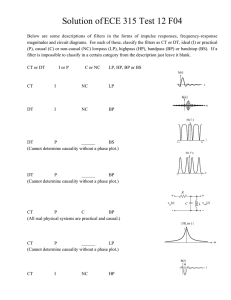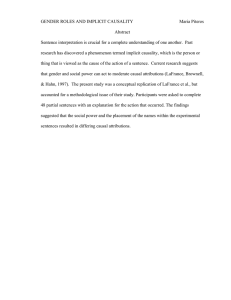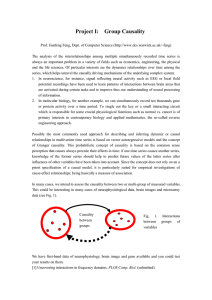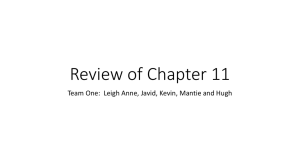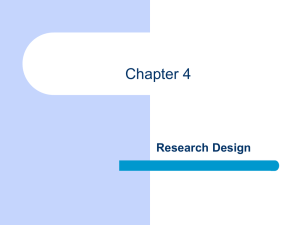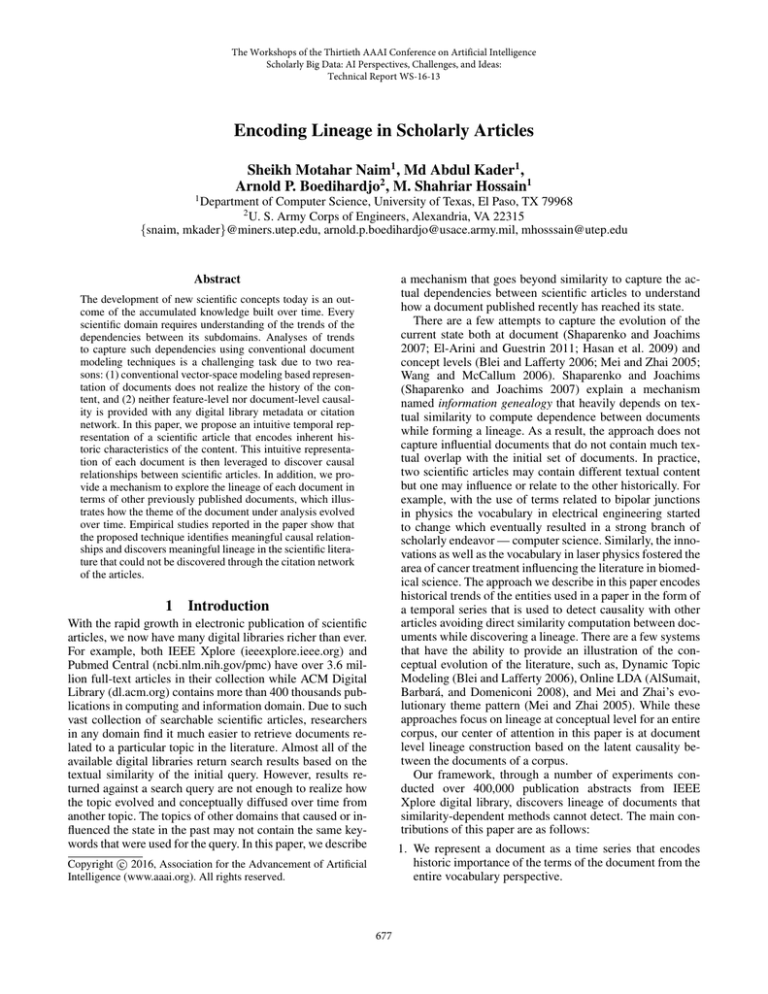
The Workshops of the Thirtieth AAAI Conference on Artificial Intelligence
Scholarly Big Data: AI Perspectives, Challenges, and Ideas:
Technical Report WS-16-13
Encoding Lineage in Scholarly Articles
Sheikh Motahar Naim1 , Md Abdul Kader1 ,
Arnold P. Boedihardjo2 , M. Shahriar Hossain1
1
Department of Computer Science, University of Texas, El Paso, TX 79968
2
U. S. Army Corps of Engineers, Alexandria, VA 22315
{snaim, mkader}@miners.utep.edu, arnold.p.boedihardjo@usace.army.mil, mhosssain@utep.edu
Abstract
a mechanism that goes beyond similarity to capture the actual dependencies between scientific articles to understand
how a document published recently has reached its state.
There are a few attempts to capture the evolution of the
current state both at document (Shaparenko and Joachims
2007; El-Arini and Guestrin 2011; Hasan et al. 2009) and
concept levels (Blei and Lafferty 2006; Mei and Zhai 2005;
Wang and McCallum 2006). Shaparenko and Joachims
(Shaparenko and Joachims 2007) explain a mechanism
named information genealogy that heavily depends on textual similarity to compute dependence between documents
while forming a lineage. As a result, the approach does not
capture influential documents that do not contain much textual overlap with the initial set of documents. In practice,
two scientific articles may contain different textual content
but one may influence or relate to the other historically. For
example, with the use of terms related to bipolar junctions
in physics the vocabulary in electrical engineering started
to change which eventually resulted in a strong branch of
scholarly endeavor — computer science. Similarly, the innovations as well as the vocabulary in laser physics fostered the
area of cancer treatment influencing the literature in biomedical science. The approach we describe in this paper encodes
historical trends of the entities used in a paper in the form of
a temporal series that is used to detect causality with other
articles avoiding direct similarity computation between documents while discovering a lineage. There are a few systems
that have the ability to provide an illustration of the conceptual evolution of the literature, such as, Dynamic Topic
Modeling (Blei and Lafferty 2006), Online LDA (AlSumait,
Barbará, and Domeniconi 2008), and Mei and Zhai’s evolutionary theme pattern (Mei and Zhai 2005). While these
approaches focus on lineage at conceptual level for an entire
corpus, our center of attention in this paper is at document
level lineage construction based on the latent causality between the documents of a corpus.
Our framework, through a number of experiments conducted over 400,000 publication abstracts from IEEE
Xplore digital library, discovers lineage of documents that
similarity-dependent methods cannot detect. The main contributions of this paper are as follows:
The development of new scientific concepts today is an outcome of the accumulated knowledge built over time. Every
scientific domain requires understanding of the trends of the
dependencies between its subdomains. Analyses of trends
to capture such dependencies using conventional document
modeling techniques is a challenging task due to two reasons: (1) conventional vector-space modeling based representation of documents does not realize the history of the content, and (2) neither feature-level nor document-level causality is provided with any digital library metadata or citation
network. In this paper, we propose an intuitive temporal representation of a scientific article that encodes inherent historic characteristics of the content. This intuitive representation of each document is then leveraged to discover causal
relationships between scientific articles. In addition, we provide a mechanism to explore the lineage of each document in
terms of other previously published documents, which illustrates how the theme of the document under analysis evolved
over time. Empirical studies reported in the paper show that
the proposed technique identifies meaningful causal relationships and discovers meaningful lineage in the scientific literature that could not be discovered through the citation network
of the articles.
1
Introduction
With the rapid growth in electronic publication of scientific
articles, we now have many digital libraries richer than ever.
For example, both IEEE Xplore (ieeexplore.ieee.org) and
Pubmed Central (ncbi.nlm.nih.gov/pmc) have over 3.6 million full-text articles in their collection while ACM Digital
Library (dl.acm.org) contains more than 400 thousands publications in computing and information domain. Due to such
vast collection of searchable scientific articles, researchers
in any domain find it much easier to retrieve documents related to a particular topic in the literature. Almost all of the
available digital libraries return search results based on the
textual similarity of the initial query. However, results returned against a search query are not enough to realize how
the topic evolved and conceptually diffused over time from
another topic. The topics of other domains that caused or influenced the state in the past may not contain the same keywords that were used for the query. In this paper, we describe
1. We represent a document as a time series that encodes
historic importance of the terms of the document from the
entire vocabulary perspective.
c 2016, Association for the Advancement of Artificial
Copyright Intelligence (www.aaai.org). All rights reserved.
677
2.5E-05
3. We propose a systematic way to track the lineage of any
published article in the form of a chain of causal documents.
Related Work
Big collections of scholarly articles from different digital libraries have been exploited in multitude of applications including keyword extraction (Caragea et al. 2014), citation
recommendation (Kataria, Mitra, and Bhatia 2010) and summarization of new contributions (Teufel and Moens 2002).
In an attempt to find the influential articles of a current document, Shaparenko and Joachims (Shaparenko and Joachims
2007) try to explain the content of a document using the textual content of previously published articles. Though this
method performs well to identify influential articles in the
literature, it is heavily dependent on textual similarity of
the documents, and therefore, fail to identify true influence where there is less or no textual overlap. El-Arini and
Guestrin (El-Arini and Guestrin 2011) and Hasan et. al.
(Hasan et al. 2009) go beyond the keyword matching and
utilize other meta-information like citations to find the related articles for a given set of papers. Another path of work
towards understanding the evolution of research has been
through incorporating temporal information into topic modeling. Mei and Zhai (Mei and Zhai 2005) find the important themes in every time frame of the corpus and connect
those themes based on their thematic similarity to show the
evolutionary transitions of different topics. Dynamic Topic
Model (Blei and Lafferty 2006) and Online LDA (AlSumait,
Barbará, and Domeniconi 2008) also track the topics over
time and provide a means to identifying emerging topics in
various time points. In this paper we introduce the concept
of causality to understanding the evolutionary nature of research. Though the idea of causality has been successfully
used in the fields of economics (Granger 1969; Cheng and
Lai 1997) and neuroscience (Roebroeck, Formisano, and
Goebel 2005), this is the first attempt, to the best of the
authors’ knowledge, to exploit Granger causality (Granger
1969) for understanding the lineage of scientific documents.
Ideal document
Real document
1.0E-05
5.0E-06
0.0E+00
1950
1955
1960
1965
1970
30.0
20.0
10.0
0.0
1950
-10.0
1955
1960
Mamm. cells
40.0
1965
Radiation Squamous
carcinoma
Tumors
50.0
Tumors Radiation
Difference of angles (degree)
60.0
1970
1975
1980
Squamous carcinoma
Radiation Drugs
Combined treatment
1975
1980
-20.0
-30.0
Figure 1: Time series generation for a document. (a) Perturbation caused by a real and the corresponding ideal document. (b) Generated signal for the real document.
• Compute a clustering, C = {C1 , C2 , . . . , C|C| } of the corpus where documents in each group Ci ∈ C demonstrate
strong causal dependence among themselves.
4
Methodology
The objective of the proposed framework is to identify
causal dependency structure of all the publications. The following subsections describe the functionalities of the proposed framework: 1) represent documents as time series,
2) identify causal groups of articles, and 3) discover causal
chains.
4.1
3
1.5E-05
Tumors
2
2.0E-05
Mammalian
Cells
Bleomycin
Estimated perturbation, π
2. Our framework provides a mechanism to cluster documents with high causal relationship.
Problem Formulation
Document Representation as a Time Series
Our framework captures the change of the distribution of the
vocabulary W over time by reading the articles in a sequence
as they were published. We compute the term distribution at
the end of every year to capture this evolving nature of the
vocabulary. Let the term distribution after the ith year be
γi = {γi1 , γi2 , . . . , γiM } where γij is the frequency of the jth
term of the vocabulary W in all the document published in
PM
or before the ith year and j=1 γij = 1.
This evolving distribution of the vocabulary enables us to
generate a time series for each document based on the relative novelty of that article. If an article d ∈ D published
in the jth year contains entities that have already been published in the literature in any ith year where i < j, then
d will not introduce much change in γi since the distribution already contains some values for those entities. Based
Let D = {d1 , d2 , . . . , dN } be the scholarly dataset of N articles containing M words W = {w1 , w2 , . . . , wM }. Each
article may contain an arbitrary number of words in any sequence. The publication dates of the documents span over a
time frame Y = {y1 , y2 , . . . , yl } where yi is ith year and
yi+1 = yi + 1. We denote the set of articles published in and
before year yi as Di . The tasks are:
• Identify the set of all causal dependencies in the corpus,
R = {(di , dj ) : dj has a causal dependence on di }.
|H |
• Construct a causal chain Hi = {h1i , h2i , . . . , hi i } for
each article di ∈ D where h1i = {di } and hqi is the set of
documents each of which has causal influence on at least
one of the documents in hq−1
.
i
678
on this concept, we replicate document d and place it in the
partial corpus Di . Let the extended corpus for document d
in the ith year be D̄i = Di ∪ d and the term distribution of
the extended corpus D̄i be γ¯i . The amount of perturbation
that document d creates in the distribution of the ith year
is estimated as the Kullback-Leibler divergence between the
original distribution γi and the distribution of the extended
corpus γ¯i .
Document studies history of microprocessors
100
Protected mode, 80286
4004, 8086, ALU
50
MC68000, 32 bit microprocessor
0
0
2
4
6
8
-50
10
12
14
16
18
20
Time
100
Document studies history of operating systems
50
Calculator, Nintendo,
Multi-user multitasking systems
Batch processing, CP/M
Windows NT, Mac OS, GUI
0
πdi =
l
X
i=1
γi ln
γi
γ¯i
0
-50
(1)
4
6
8
10
12
14
16
18
20
Time
Figure 2: An illustrative example of causality between two
documents based on their signals.
The order of two distributions γi and γ¯i in Equation 1 is
important due to the asymmetric nature of KL-divergence.
Since our intention is to measure the extra information added
to the corpus Di by the inclusion of document d, we always
compute the KL-divergence from γi to γ¯i , not the other way
around.
By placing d in each year yi ∈ Y we get a time series
πd = {πd1 , πd2 , . . . , πdl } for d that represents the document’s
influence on the vocabulary over all the years. The red line
in Figure 1(a) shows this perturbation-based time series of a
sample document.
In the next step, we create a synthetic document d0 that
is an identical copy of d but each of the terms being encoded by a unique identifier. That is, the terms in the synthetic document do not appear in any of the documents in the
entire corpus D. This ensures that d0 independently holds
the properties of d as a single document but it is a novelized one since none of the documents contains the synthetic
terms. Now following the same procedure as we used for
d, we add d0 to Di to form an extended corpus D̄i0 , calculate the term distribution γ¯i0 for that corpus, and estimate
the amount of perturbation d0 could introduce. We construct
πd0 = {πd10 , πd20 , . . . , πdl 0 } for d0 the same way as we computed πd . The blue line in Figure 1(a) is the signal generated
by placing d0 in every year. Since the content of d0 is unique,
the line for d0 will always have larger (or equal) value in
every year than the line for the real document d.
The time series πd0 is a representation of the degree of influence the document d would have had on the vocabulary
had it be a completely unique document. Therefore, the difference between the two time series πd and πd0 gives us an
estimation of the amount of uniqueness of document d in
every year of the corpus — the smaller the difference the
closer it is to the extremely unique document. Figure 1(b)
shows the signal for d that is derived from the difference
between πd and πd0 . We denote this signal as Sd and calculate its magnitude in ith year as the difference between the
angles created by the time series πd and πd0 at the ith year.
4.2
2
ity (Granger 1969) is a statistical hypothesis test which estimates the usefulness of one time series in predicting the
future values of another time series. A time series X is said
to Granger-cause another time series Y if it can be shown
that those X values provide statistically significant information about future values of Y . We use Granger causality to
test if there exists any causal relationship between two documents. Assuming that the document di was published before
the document dj , we test the following hypothesis to identify
a causal effect from di to dj :
P[dj (t + 1) ∈ A|I(t)] 6= P[dj (t + 1) ∈ A|I−di (t)]
(2)
where P indicates probability, A is an arbitrary non-empty
set, and I(t) and I−di (t) respectively denote the information available as of time t in the corpus, and that in the corpus
excluding di . If the above hypothesis is accepted, we say that
document di Granger causes document dj . Figure 2 demonstrates the causal relationship between two documents based
on their time series.
Once we identify the set of all the causal relationships R
in the corpus, we can build a causality network or a causality
matrix. In practice, for large corpus we limit causality computation for any document to the documents published in r
previous years only. The set of IEEE publications that we
use in the experimental results section spans over 54 years,
and we vary the value of that look-back threshold r from 8
to 10 years for our experiments.
The strengths of the causal relationships in R allow us to
use clustering algorithms to find causal groups of articles.
We use a density based clustering algorithm DBSCAN to
group causal documents. The motivation behind the use of a
density based clustering is that this specific family of clustering algorithms does not require the number of clusters k
as an input (unlike k-means clustering). DBSCAN is a logical choice for causal partitioning since there is no metadata
that can help us identify possible number of causal clusters.
Identification of Causal Clusters
The information provided by an article published today is an
outcome of knowledge accumulated over time in the past.
Each article in a corpus of a certain domain is very likely
to have a few articles to which it is causally dependent.
We use the signal Sd generated for each document d ∈ D
to compute the causalities between all articles. We leverage Granger causality test in this purpose. Granger causal-
4.3
Computing Causal Chains
Algorithm 1 provides a chain of causal documents for a
given document di . Each chain is a graph or tree containing
causality flows from leaf documents toward the document
for which the lineage is generated. The chain is initialized in
line 1-2 with the given document di . We expand the chain
679
defined as
Algorithm 1: ComputeLineage – algorithm to compute the causal chain of a document.
input
: Document di
parameter: Set of causal pairs, R
Look-back threshold, r
Branching factor, b
output
: Lineage of di , hi
1 create an empty list hi ;
2 append {di } to hi ;
3 do
4
create an empty set Sp ;
5
S ← read the last set from hi ;
6
for each document d ∈ S do
7
Rd ← {(dp , dq ) : (dp , dq ) ∈ Rd and dq = d}
if |Rd | > b then
8
Rd ← top b pairs of Rd ;
9
end
10
for each causal pair (dp , dq ) ∈ Rd do
11
if yearOf(dq ) - yearOf(dp ) ≤ r then
12
add dp to Sp ;
13
end
14
end
15
end
16
if |Sp | =
6 0 then
17
append Sp to hi ;
18
end
19 while |Sp | =
6 0;
20 return hi
|P |
n−3 n−1
1 X X
1 X
1−
D(d) =
disp(dpi k , dpj k )
|P |
n − 2 i=0 j=i+2
k=1
(3)
where
(
disp(dpi k , dpj k )
=
dpi k and dpj k have term overlap
otherwise.
1
n+i−j
0
Larger values of D(d) indicate better diffusion over time
while smaller values will refer to lesser conceptual drift.
In addition, we examine how much of the lineage generated by our approach overlaps with the citation tree formed
for a document. Let T citation (d) and T causality (d) are the
ancestor trees of depth L of a document d ∈ D generated using the actual citations and causal relationships, respectively.
Then a citation overlap score for article d can be defined as:
Acausality (d) =
L X
T citation (d) T causality (d) l
∩ η̂l
ηl
× (4)
L
l=1
T
citation
(d)
T causality (d)
where ηl
and η̂l
are the set of references of documents at level l of the tree T citation (d) and
T causality (d) respectively. The same equation can be used
to compute citation overlap score Asimilarity for a similarity based lineage as well as Agenealogy for an information
genealogy based approach.
We express the degree of causality within the documents
in the same topical group t as causal density score ρ(t):
ρ(t) =
by adding new set of documents that have causal influence
on the documents of the previous set. Each document d in a
level is expanded to b articles with highest causalities on d
which were published within r years of the publication date
of d. The procedure terminates when there is no more causal
parent left to expand from a certain level.
5
!
2 × |Rt |
nt × b
(5)
where b is the maximum number of causal parents considered for each document, Rt ⊂ R is the set of causal relations within topic t and nt is the number of documents in t.
We also calculate the causal influence of a topic t1 on another topic t2 as:
φ(t1 , t2 ) =
Evaluation
|{(di , dj ) ∈ R : di ∈ Dt1 , dj ∈ Dt2 }|
nt1 + nt1
(6)
where Dt1 and Dt2 are the set of documents in topic t1 and
t2 respectively. Finally, the causal dominance ψ(t) of a topic
over the other topics in the corpus is calculated as
1 X X X 1 (d, d0 ) ∈ R
ψ(t) =
(7)
0 otherwise.
nt
t 0
0
t0
We evaluate our framework by evaluating the quality of
causal clusters, how much information is diffused over time
in a lineage, and comparing the lineage produced by our approach with a similarity based model, information genealogy (Shaparenko and Joachims 2007), and a citation network based lineage.
d∈D t ∈T d ∈D
where T is the set of all topics
One of the evaluation metrics we use is diffusion coefficient, which estimates a quantity of how the theme changed
over time. The basic assumption here is that a lineage of
scholarly articles should diffuse a concept over the years
and generate new ideas. Let P = {p1 , p2 , . . . , p|P | } be
the set of paths in the lineage of a document d ∈ D, and
k
pk = {dp0k , dp1k , . . . , dpn−1
} be the kth path in P containing
pk
n documents and d0 refers to the source document d. Diffusion coefficient D(d) of lineage of the document d is then
6
Experimental Results
In this section, we seek to answer the following questions
to justify the capabilities and correctness of the proposed
model.
1. How does the causality based clustering mechanism compare to a baseline similarity based clustering approach?
(Section 6.1)
680
A cluster of documents with smaller number of
terms overlaps
Cluster Size=24
Epidemic spreading in
real networks: an
eigenvalue viewpoint
2001
Measuring and
modeling computer
virus prevalence
1993
Percentage of document
clusters distributed to T term
clusters
Causality based document clustering
Baseline (Similarity based clustering)
40
30
20
10
4
6
6-9
8
8-11
10
10-13
12
12-15
14
Abstract—In this paper, we present
a new data mining algorithm which
involves incremental mining
Abstract—As technology
advances we encounter more
available data on moving
objects
Indexing the
Trajectories of
Moving Objects in
Networks
Parallel Mining of
Association Rules
1996
Abstract—To understand the
current extent of the computer
virus problem and predict its future
course, the authors have
Abstract—We consider the
problem of mining association
rules on a shared nothing
multiprocessor
1991
Incremental
implementation model
for relational
databases with
transaction time
Abstract—An implementation
model for the standard relational
data model extended with
the x-axis are ordered based on percentage of documents in
a cluster containing those terms. The top twenty frequent
terms are shown for each cluster. The plot in the left shows
that the documents in a highly causal cluster have large
amount of term overlaps. For example, 32% and 23% of the
documents contain the terms cluster and structure, respectively. In contrast, the plot at the right side illustrates that
the documents in a highly causal cluster can have comparatively low textual similarity. The most frequent term “way”
appears in just 12.5% of the documents of the causal cluster represented by the plot at the right side of Figure 3. This
stipulates that a causal cluster of documents may or may not
be similar in terms of textual contents.
While Figure 3 shows an evidence that similarity is not
the key indicator of causality, it does not confirm that highly
causal documents grouped in a cluster are causal at the feature level. To examine whether a causality based grouping
of documents brings more causal items together than a similarity based grouping, we cluster all the documents based
on causality and similarity separately. Then we cluster all
the terms of the corpus based on term causality considering
the frequency of each term in each year as the amplitude of
the corresponding term signal. Additionally, we apply topic
modeling to the corpus and assign a topic to each of the articles. We seek to verify the causality of the terms of the documents of a causality based cluster by examining the dominant terms of the topics of the documents of that causal cluster. Those dominating terms should come from a small number of causality based term clusters. In contrast, the dominant topical terms of a similarity based cluster of articles will
tend to come from multiple causal term clusters if causality and similarity are less relational. Figure 4 shows that the
dominant topical terms of causality based document clusters
are distributed to small number of causal term clusters indicating that causality based document clusters are highly
causal at term level. The similarity based document clusters exhibit a different trend. The topical terms of the simi-
60
4-7
2003
2006
Figure 5: The causal chain of a document discovered by the
proposed method.
70
2
Abstract—How will a virus
propagate in a real network? Does
an epidemic threshold exist for a
finite graph?
Developing Data
Allocation Schemes by
Incremental Mining of
User Moving Patterns
Abstract—The management of
moving objects has been
intensively
80
2-5
Abstract—The real-world
process of generating a large
spatio-temporal data collection
2004
One may argue that one particular scholarly article is only
motivated by similar articles published in the past. While
similarity is a good way to discover articles published on
the same topic, the inter-topic influence cannot be captured
using similarity search. To verify whether highly causal document clusters are always similar or not, we analyze the similarity between the documents of each of the causal clusters
detected by density based clustering (as described in Section
4.2). Figure 3 shows the percentage of documents that share
certain terms in two different causal clusters. The terms in
0
A Spatio-Temporal
Simulation Model
for Movement
Data Generation
A Compact
Representation of
Spatio-Temporal Data
Causality based vs. Similarity based
clustering
0
2008
Abstract—Viral Marketing, the
idea of exploiting social
interactions of users to
propagate
2. Can the proposed lineage formation approach identify genealogies drifted from other topics? (Section 6.2)
3. Which topical groups have most causal influence on the
other topical groups in the entire corpus? (Section 6.3)
We collected a publication dataset of titles and abstracts
along with some meta-data that includes publication year
and citations of each paper. The collection contains 412,484
computer science articles from the IEEE Xplore digital library. The computer science articles are recognized by entries available in the DBLP computer science bibliography
database. This collection contains documents from the year
1961 to 2014. We extracted over eight hundred thousand entities from the titles and the abstracts using lingpipe, Stanford NER and openNLP entity detectors (Hossain et al.
2012). The entities were then tokenized to construct the feature set for each document.
50
Abstract—Mobile networks
enable users to post on social
media services (e.g., Twitter)
2009
Figure 3: Comparison of two highly causal clusters in term
of the textual similarities among the documents of each cluster.
6.1
Spatio-Temporal
Topic Modeling in
Mobile Social Media
for Location
2012
Recommendation
Viral Marketing for
Multiple Products
way
present
tree
topic
relationship
rule
order
feature
preface
knowledge
point
process
dataset
canonical
network
expert
content
discovery
scalability
difficulty
cluster
structure
text
feature
complexity
space
effectiveness
order
clustering
feature space
classification
process
term
eb
data set
mixture
respect
web
dimensionality
similarity
Percentage of documents
with term overlap
Cluster Size=22
50
45
40
35
30
25
20
15
10
5
0
Percentage of documents
with term overlap
A cluster of documents with large number of term
overlaps
50
45
40
35
30
25
20
15
10
5
0
16
14-17 16-19
Number of Term Cluster, T
Figure 4: Comparison between causality based and similarity based document clustering with respect to the causality
based term clustering.
681
of keyword search resulting in similar topics. Our approach
exhibits the least amount of overlaps with the citation network among three approaches. In contrast, Figure 6(right)
shows that our approach has the highest average conceptual
diffusion over time than all other methods, even when compared to the original citation network. This indicates that our
approach has the ability to detect how the lineage drifted
from another topic and formed the current literature, which
other methods do not possess.
larity based article clusters spread into comparatively large
number of causal term clusters. This indicates that the documents inside the causal groups identified by our proposed
framework are more causal at feature level than a grouping
discovered by a similarity based baseline approach.
6.2
Lineage Formation
Figure 5 shows an example of a lineage identified by Algorithm 1 for a document in the IEEE Xplore library (Article
Reference Number: 6729600). The branching factor we used
for this lineage is b = 4 and the look-back threshold r = 10.
The initial document for which the chain is formed embeds
spatio-temporal data, social media, and recommender system in one paper. The causal paths shown in the lineage illustrates that the topic of this document was influenced by
different areas of research including relational database with
temporal aspects, association rule mining, network analysis, and viral marketing in social media. The chain discovers
more causal articles than similar ones to form the lineage.
Overall, we evaluate the lineage in terms of diffusion coefficient (Equation 3) and citation overlap (Equation 4). Figure 6(left) compares average citation overlap scores at different levels of all the lineages detected for all documents
using three approaches (1) our causality based approach, (2)
similarity based approach, and (3) information genealogy
based approach. The figure shows that the similarity based
approach has the highest overlap with the citation lineage.
This matches the fact that citations are generally outcomes
6.3
In this section we infer the notion of document-level causality to understand topic-level influential relationships in the
literature. For the experiments in this section we used the
documents published in ICDM conferences and workshops
from 2001 to 2014, which is a subset of the IEEE dataset
used in the preceding experiments. We apply LDA (Blei, Ng,
and Jordan 2003) with 20 topics on this ICDM data set to get
the distribution of topics in each document. We categorize a
document to be under the topic which has the highest probability in that document.
If the documents under a particular topic are mostly
caused by the other documents in that topic, the topic is
supposed to depict more causal density (Equation 5). Figure
7(left) shows the causal density of different topics for b = 5.
From the figure we can see that documents related to outliers
detection (topic no. 8) and association rule and subgraph
mining (topic no. 10) are mostly caused by the documents
under the same topic. On the other hand, the research areas that inspired or were inspired by a variety of other fields
should demonstrate strong causal relations across the topics.
Figure 7(middle) shows the pairs of topics that have most
causal influence calculated by Equation 6. Each edge in the
figure is labeled with the value of φ(t1 , t2 ). There are some
areas in the literature that are more dominant than others and
hence cause more documents within and across the topics.
Figure 7(right) shows the top five dominant topics with their
causal strengths computed by Equation 7.
Based on the causal relationships found among the topical groups of documents, our observation is that the topics with higher cross-topic causality has low causal density
(e.g. topic number 5 and 18). Topic 10 is an exception in that
sense, which is the reason behind its being the most dominant topic in the entire corpus.
Average citation overlap
score
0.6
0.5
0.4
0.3
0.2
Causality based
Similarity based
Genealogy based
0.1
0
0
2
4
6
8
10
Tree depth, L
0.04
Average diffusion
coefficient
Analyzing Topical Causality
0.035
0.03
0.025
7
0.02
Causality based
Similarity based
Citation based
Genealogy based
0.015
0.01
0.005
In this paper we present a novel time series based representation for scientific articles that enables searching beyond
mere content similarity. Though such representation is intuitive and has shown superior ability in identifying actual
causal relationships between the documents, we are yet to
comprehend all of the characteristics of these signals. One
direction of our research is going towards having a better understanding of these document signals and applying them to
identify even more subtle causalities. We also have shown a
mechanism to find a causal chain of documents for any given
document and then inferred those chains to topical groups of
documents in order to see the causal relationships between
0
3
3.5
4
4.5
5
5.5
6
6.5
Conclusion
7
Length of a lineage chain
Figure 6: (left) Average citation overlap scores for three
approaches: 1) our causality based approach, 2) similarity based lineage, and 3) information genealogy based approach. (right) Our causality based framework demonstrates
the highest form of conceptual diffusion over time.
682
10"
16"
Topic%19%
0.16%
Topic%13%
Topic"ID"
7"
Topic%10%
0.23%
0.2
0.15
0.09%
8"
0.19%
0.1
Topic%16%
0.05
0.04%
2"
Causal0Density0of0Topic
0.3
0.25
0.15%
0
1 2 3 4 5 6 7 8 9 10 11 12 13 14 15 16 17 18 19 20
Topic0ID
Topic%4%
0"
Topic%7%
0.5"
1"
1.5"
2"
2.5"
3"
3.5"
4"
4.5"
5"
Causal"strength"
Figure 7: (left) Within-topic causality score of different topics. (middle) Topic pairs with most causal relation between them.
(right) Topics with most causal strengths.
Mei, Q., and Zhai, C. 2005. Discovering evolutionary theme
patterns from text: an exploration of temporal text mining. In
KDD’05, 198–207.
Roebroeck, A.; Formisano, E.; and Goebel, R. 2005. Mapping directed influence over the brain using granger causality and fmri. Neuroimage 25(1):230–242.
Shaparenko, B., and Joachims, T. 2007. Information genealogy: uncovering the flow of ideas in non-hyperlinked
document databases. In KDD’07, 619–628.
Teufel, S., and Moens, M. 2002. Summarizing scientific articles: experiments with relevance and rhetorical status. Computational linguistics 28(4):409–445.
Wang, X., and McCallum, A. 2006. Topics over time: a
non-markov continuous-time model of topical trends. In
KDD’06, 424–433.
different topics. However, a direct approach towards understanding the topical evolution – how one concept begets
other new ideas, gets merged with some other concepts, or
simply vanishes away at some point – and the causal factors
behind those behaviors of topics would be more interesting.
8
Acknowledgments
This work is supported in part by University Research Institute (URI, Office of Research and Sponsored Projects,
UTEP) and U.S. Army Engineering Research and Development Center under Contract No. W9132V-15- C-0006.
References
AlSumait, L.; Barbará, D.; and Domeniconi, C. 2008. Online lda: Adaptive topic models for mining text streams with
applications to topic detection and tracking. In ICDM’08,
3–12.
Blei, D. M., and Lafferty, J. D. 2006. Dynamic topic models.
In ICML’06, 113–120.
Blei, D. M.; Ng, A. Y.; and Jordan, M. I. 2003. Latent
dirichlet allocation. Journal of machine Learning research
3:993–1022.
Caragea, C.; Bulgarov, F.; Godea, A.; and Gollapalli, S. D.
2014. Citation-enhanced keyphrase extraction from research
papers: A supervised approach. In EMNLP’14.
Cheng, B. S., and Lai, T. W. 1997. An investigation of cointegration and causality between energy consumption and
economic activity in taiwan. Energy Economics 19(4):435–
444.
El-Arini, K., and Guestrin, C. 2011. Beyond keyword
search: discovering relevant scientific literature. In KDD’11,
439–447.
Granger, C. W. 1969. Investigating causal relations by
econometric models and cross-spectral methods. Econometrica: Journal of the Econometric Society 424–438.
Hasan, M. A.; Spangler, W. S.; Griffin, T.; and Alba, A.
2009. Coa: Finding novel patents through text analysis. In
KDD’09, 1175–1184.
Hossain, M. S.; Butler, P.; Boedihardjo, A. P.; and Ramakrishnan, N. 2012. Storytelling in entity networks to support
intelligence analysts. In KDD’12, 1375–1383.
Kataria, S.; Mitra, P.; and Bhatia, S. 2010. Utilizing context in generative bayesian models for linked corpus. In
AAAI’10, volume 10, 1.
683


